What to do if you scratch a mole? This is a common question. Damage to moles is a fairly common situation. Often moles appear on exposed areas of the body, where they are susceptible to injury and friction.
Most often, nevi (moles) appear on the human body in childhood, but it is possible that they form in adulthood. To understand what will happen if you injure a mole or have any other damaging effect on it, you need to know what these skin structures are.
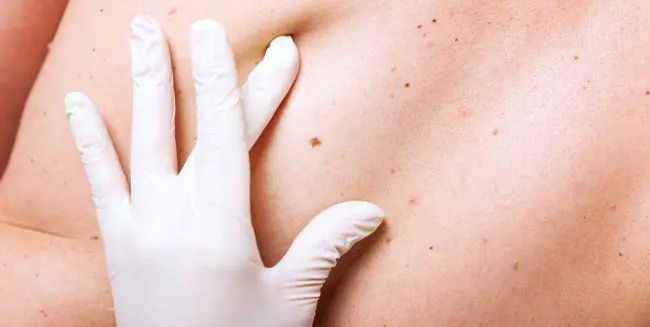
What to do if you scratch a mole is of interest to many.
A little about moles
Essentially, moles are considered benign epidermal growths consisting of cells that contain excess amounts of natural pigments, such as melanin. The formation of such structures can be caused by a variety of external and endogenous factors, ranging from hormonal imbalance to ultraviolet influence. Most often, nevi appear on the body in childhood, and in adulthood their formation may be a manifestation of a physiological norm, however, this may be a signal of the emergence of a pathological process, for example, cancer.
Connection with oncology
Moles of any visual characteristics and location are often associated with cancer processes, which has certain reasons. Dermatologists note that under the influence of certain accompanying factors, any mole can transform into melanoma, which is a dangerous oncological degeneration of the skin. One of these factors is nevus trauma.
Is it dangerous if you scratch a mole?
Injury factors
There are several types of nevi, each of which has an individual degree of risk of injury:
- Flat moles - externally similar pigmented structures do not rise above the surface of the epidermal cover, which significantly reduces the risk of mechanical damage to a mole of this type.
- Convex moles are formations that protrude beyond the boundaries of the surface layer of the skin. Convex nevi are often exposed to traumatic effects due to contact with tight clothing, accessories and shoes, as well as during the process of combing, washing or performing certain physical work.
- Hanging moles - such neoplasms are most often subject to injury, which is due to their morphological characteristics.
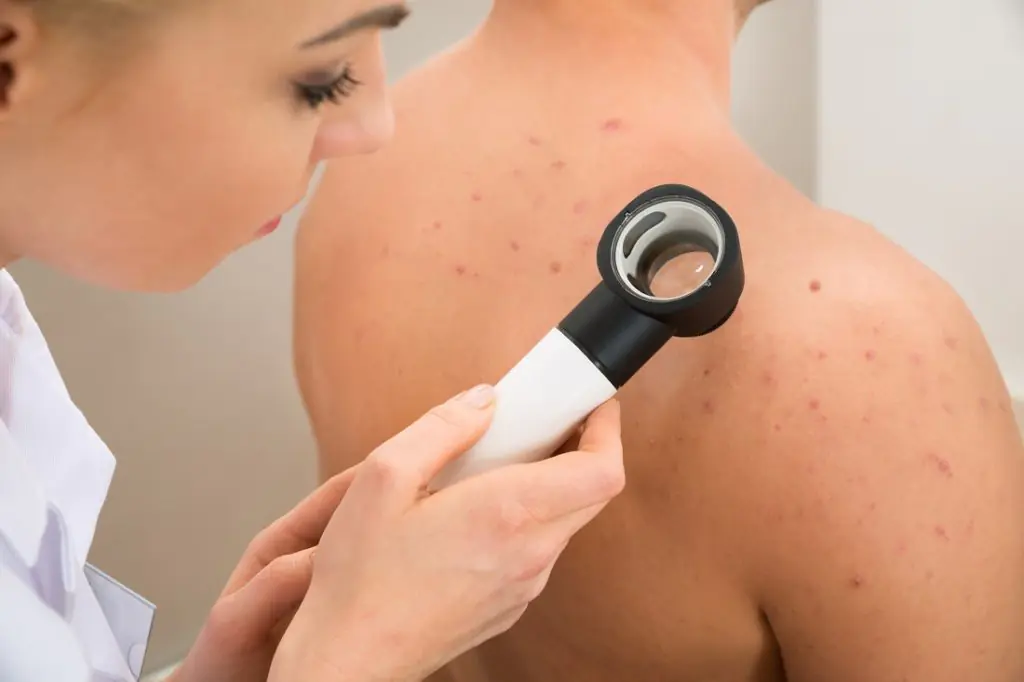
The last two categories of nevi require very careful handling and constant monitoring. In addition, the risk group, whose representatives often encounter damage to skin nevi, usually includes children and women. The latter top this statistics due to their adherence to uncomfortable tight clothing and various accessories that often injure the body of the mole. Children scratch or tear off moles often unconsciously, during play.
What if you scratched a mole and it started bleeding?
Bad sign
Blood from a mole is considered a bad sign. In this case, it is necessary to stop the bleeding and urgently contact a specialist for examination of the nevus and further therapy (removal of the formation may be required). It is also necessary to carefully examine the nevus: if it is scratched or torn, then this is the cause of the bleeding.
However, it often happens that the bleeding is not caused by trauma to the mole. In such a case, the formation is either slightly scratched or only partially torn off, or the case is even more complex. There is a certain risk that the mole has become dead and inflamed, which causes such bleeding. In any case, the cause of bleeding from the nevus should be consulted with a doctor. There is no need to worry, since neither the collection of tests nor the procedure for removing this formation, if necessary, causes pain or difficulty.

Why does blood come from a mole?
If you scratch a mole and it bleeds, this is a very bad sign. If everything is fine with the mole, it does not grow and does not change its appearance and color, then there is no need to touch it. However, if it is profusely engorged with blood or bleeding occurs from the nevus, this is a sign of a certain pathology that must be clearly diagnosed. A healthy formation will not bleed, so if blood comes from the nevus, it means it is injured.
Sometimes it happens that you scratch a mole without bleeding.
Causes of mole injuries
There can be several reasons for injury to a mole:
- If a person accidentally tears off a mole completely or partially.
- Scratches of moles.
- Friction of the location of the mole.
- Scratching moles due to certain skin diseases.
In fact, there is only one reason for the occurrence of mole injuries - inattention towards it. Every mole requires observation and care. When bathing and grooming, you should always be aware of them and avoid unnecessary exposure. In addition, a nevus can be injured in different ways.
If a mole is seriously injured, blood may come out. For minor injuries, for example, light scratches, there may not be blood, but you should contact a specialist in any case.
Is it scary if you scratch a mole badly?
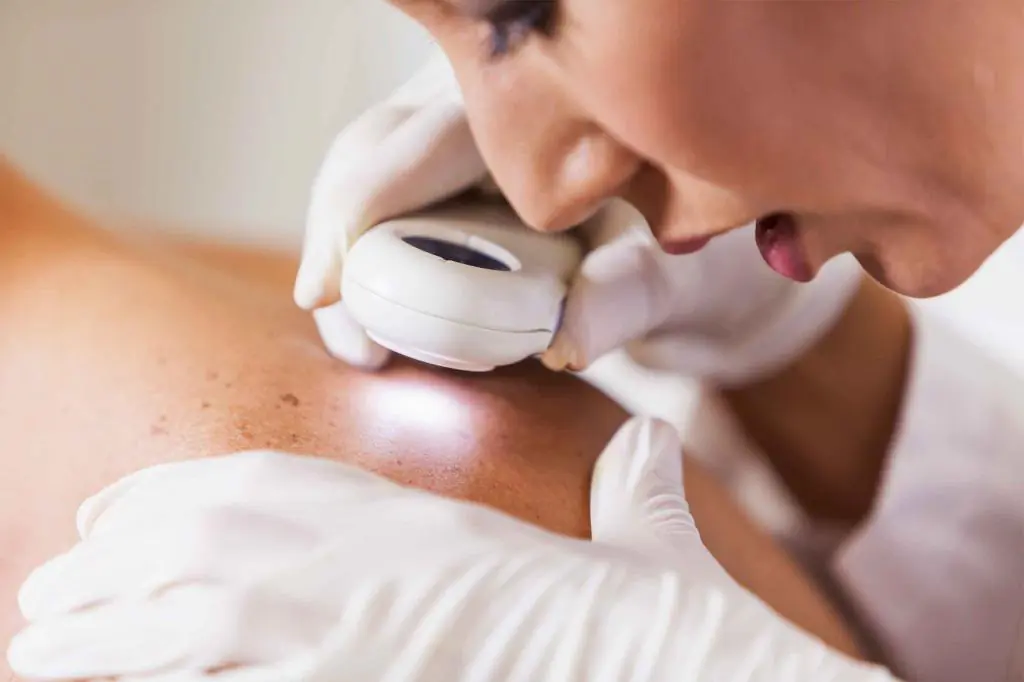
Is a mole injury dangerous?
Clinical studies have confirmed that in almost 50% of cases, the formation of melanoma is preceded by trauma to pigmented nevi (moles). Some doctors consider these statements controversial, but it is too early to consider the discussion closed. There are many cases where, after a scratch or other injury to a mole, such disorders went away without a trace, and almost every person has injured a nevus at least once in their life. People also complain that the cat scratched a mole. However, statistics are difficult to dispute, so you need to be vigilant.
Symptoms of violation of the integrity of a mole
If painful sensations or a feeling of discomfort appear, it is necessary to urgently take measures aimed at establishing the causes and further treatment of the phenomenon on the epidermal surface. Several of the most common symptoms of general nevus disorders:
- the skin has uneven edges around the formation;
- signs of asymmetry in the shape of the mole appeared;
- the color of the nevus has changed;
- increase in size of formation;
- the occurrence of pain or discomfort.
Self-medication is unacceptable
When a child scratches a mole, trying to treat it yourself is highly inadvisable, since such procedures can cause serious harm by introducing infection into the damaged area. The main complication in this case is the development of malignant processes, which are caused by pathological transformation of the cellular structures of the nevus.
It is for this reason that every person, if possible, should visit a doctor who will carry out the necessary diagnostic measures to examine the mole, which will help identify the presence of certain diseases.
Treatment
When a person scratches a mole until it bleeds, in modern clinical medicine these problems are solved in several available ways:
- electricity;
- laser removal;
- cauterization.
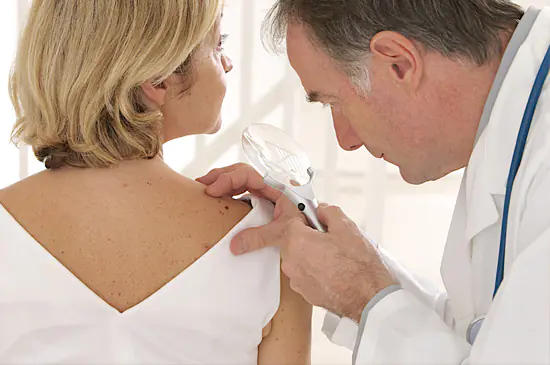
Together with any of the methods described above, the patient can get rid of nevus on the skin and eliminate the pain that is often observed with injuries and diseases of moles.
So, I scratched the mole until it bled. The doctor will tell you what to do.
Removal techniques
If the doctor decides to remove a mole, this can be done using the following modern techniques:
- surgical removal;
- removal with nitrogen (cryodestruction);
- electrocoagulation;
- laser therapy;
- radio wave excision – getting rid of a mole using high-frequency waves.
Surgical removal is considered the most reliable method for removing damaged moles. The surgeon cuts off the formation with a scalpel and cauterizes the wound. Then an antibiotic and a special bandage are applied to the surface. Sometimes the mole and its surrounding surface are removed. The size of this area affects the possibility of developing a malignant process. After cutting out large areas, stitches are placed.
The cryodestruction method is used for small moles and papillomas in prominent places. Using an applicator, liquid nitrogen is applied to the mole, where a bubble appears. It subsequently shrinks and forms a crust, which then falls off and new skin remains in place. Dermatologists confirm this. What to do if you scratch a mole, you should first check with them.
Electrocoagulation fights annoying moles, warts, HPV, acne and many other ailments. When removing a mole with an electric coagulator, the specialist selects the power of the device and, using a loop-tip, begins to influence the mole through an electric current.
Laser therapy is suitable for removing small tumors. Today, this procedure is recognized as the most effective method for removing a mole on the face. Its essence is the complete elimination of education. To remove a mole without damaging surrounding areas of the skin, a beam with a certain wavelength is selected. Its effect is aimed at melanin, which is contained in moles.

Injury to moles: consequences
First of all, it should be noted that the development of the oncological process is not always associated with scratches or other damage to pigmented nevi, and melanoma will not necessarily be a consequence of such a phenomenon. At the same time, scientists have proven that for moles that are initially classified as melanoma-hazardous, trauma to the surface can lead to an acceleration of the onset of a pathological malignant process. This is one of the main reasons why it is necessary to protect any nevi from all kinds of aggressive influences that damage their structure.
In addition to malignant transformation, there are several other dangerous consequences that may result from torn or scratched moles:
- Development of severe bleeding. The body of the nevus is equipped with many blood vessels that saturate the cells of this formation with oxygen and nutrients. Some nevi, such as hemangiomas and angiomas, are composed entirely of a plexus of blood channels. In this regard, if such a formation is damaged, severe bleeding can occur, which can only be stopped through medical care. After visual healing, such a mole often bleeds for a long period of time, which is a consequence of injury.
- Attachment of infections. The open wound surface that forms at the site of the damaged nevus provides rapid access for various infectious agents to the skin, and, accordingly, to the entire human body. As a result, a local infectious process or a generalized pathological condition may develop, which is accompanied by suppuration of the areas of contamination.
- Inflammatory processes. Often after mechanical trauma to a nevus, people notice swelling of the area around the mole and hyperemia of the skin. This, along with pain during touching, may indicate the development of an inflammation process. This reaction is often accompanied by spasm of the blood vessels, which is manifested by the appearance of a white spot around the injured mole. If left untreated, this process can lead to suppuration of the wound surface.
- Formation of scars and scars. This aspect especially worries women when she scratches a mole on her face with some accessory or manicure. The consequence of such a careless attitude can be an aesthetic defect that forms against the background of excessive growth of connective tissue. Subsequently, such scars can only be removed using special cosmetic techniques.
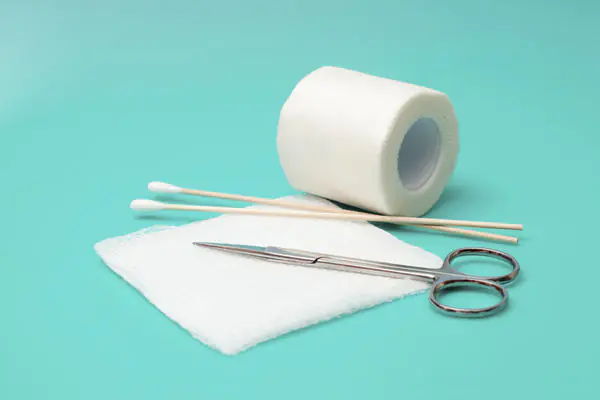
To avoid the unpleasant phenomena described above, it is necessary to treat moles with care and attention and, best of all, remove the formation located in the high-risk area in advance.
How to stop bleeding
What to do if a child scratches a mole?
If blood comes from a mole after an injury, the necessary measures should be taken. The first thing to do is take cotton wool and 3% hydrogen peroxide and cauterize the bleeding area on the skin. After this, take a sterile bandage, fold it into 2-3 layers and apply it to the mole for 10-15 minutes until the bleeding stops.
The article discusses what to do if you scratch a mole.
Parents behave differently when they notice moles on their baby’s skin. Some experience fear when thinking about possible harm to their health; others find them great. Who is right? Should I worry and worry?
A mole is a congenital or acquired malformation of the skin. It appears unexpectedly on the body, most often on the face, in all people. In newborns, dotted moles are very rare. They actively appear in 2-year-old children, and besides, even then they are difficult to distinguish.
Another stage in their appearance begins during puberty. All due to changes in hormonal levels: old ones become larger and brighter, and new ones occupy previously unoccupied areas on the body. The small brown round spots are harmless as long as you don't injure or rub them. Otherwise, the risk of moles degenerating into melanoma increases.
What happens if a child rips off or picks at a mole?
Nevus or mole - skin formation, which is responsible for the formation of tanning and skin pigmentation. Although myths have been created about her, not all of them can be believed. It is a tumor in its structure, which does not change in size and does not harm the baby’s health until he damages it.
It is impossible to predict the consequences of damage to a mole! They are influenced by size, shape and inherent cancer predispositions. If the nevus is large, it will cause serious harm to health. When it is damaged, the cells responsible for producing tan break out. They infect the body, increasing the risk of developing skin cancer.
Why is damage to the growth dangerous?
Children often injure moles, as do adults, who already know about the dangers of pigmented formations. They injure their knees and feet, hands and neck when falling from a bicycle. They don’t do this on purpose, but the consequences in this case are difficult to predict.
If a child picks off a mole, the affected area is treatedto prevent the risk of developing an infection in the resulting wound. If you don't do this, melanoma will develop in the future.
If parents notice numerous neoplasms in a child, they should monitor them. Large pigment spots pose a threat to health.
You will need to consult a doctor to prevent them from degenerating into melanoma.
He will advise careful monitoring of neoplasms and drawing up a schedule of examinations. The schedule will subsequently determine whether they are increasing in size or not.
They became wary when the mole acquired pronounced asymmetrical edges with numerous teeth. They also noticed that the nevus changed its color from brown to gray, black, blue, pink-red, etc. It has increased in size - up to 6 or more millimeters.
The signs listed above are alarming and force you to see a doctor, but after tests and a thorough examination, a serious diagnosis is made. Everything would have been different if the visit to the doctor had not been postponed. By the way, in most cases, parents are not aware of serious problems with their baby’s moles.
They are concerned about other manifestations:
- rapid weight loss,
- complaints of bone pain,
- malaise,
- vision problems,
- etc.
Dangers of picking off a nevus
Even if the mole was simply scratched or the child scratched it, consult a doctor immediately. Otherwise, death may occur.
What to do and how to treat the wound?
Before starting to provide primary care, parents are advised to calm down.
Only in rare cases does a mole degenerate into a malignant tumor.
If you start acting without panic, you prevent its development and all the negative consequences associated with it.
If a child, while playing with other children, scratches his mole, but without separating it from the skin, do the following:
- treating the damaged area with hydrogen peroxide. This remedy works well to stop bleeding. After this, they begin to treat the surface with an alcohol-containing solution. If you have chlorhexidine in your medicine cabinet, even better.
- Ensuring that the affected area is protected by other damage. Taking a patch with a pad, seal it, thereby preventing contact with ultraviolet rays.
- Consultation with a doctor. It is better to play it safe in case of severe or minor damage to the tumor. If you don’t delay going to the doctor, you may be able to prevent the development of melanoma by removing the tumor.
Sometimes during the game they only touch a mole. In such cases, parents can treat it with an antiseptic composition and observe it and the child’s well-being for several days. They do not go to the doctor if it has not increased in size, changed its color, does not itch or bleed.
When and how should a tumor be removed?
Severe damage to the nevus is a clear reason for removal. You should not be afraid of a mini-operation, since modern techniques and materials have appeared in dermatology to carry it out without consequences.
A small scar will remain at the site of the mole, and even then not all children have it.
Ways to remove moles:
- Laser. It is used more often than any other technique. The reason for its popularity is the rapid healing of wounds after exposure to it.
- A liquid nitrogen. This method is effective and painless. There are no scars left at the site of exposure. The weakness is the impossibility of removing the nevus in one go.
- Electricity. Strengths: getting rid of moles in the first session, eliminating all types of birthmarks. The downside is the appearance of a small scar on the skin.
It is advisable not to choose a nevus removal method at random, relying on stories from friends and articles on the Internet. It is important to consult a doctor who will tell you which method is best to use in a particular case. They are not afraid of mini-operations: removal reduces the risk of the tumor degenerating into melanoma.
It is difficult to protect a child from mechanical damage. He is mobile and active. Suggestions will not help in this case. In some cases, avoiding wearing tight, tight clothing and jewelry in places where moles accumulate can help.
Useful video
Damage to a mole
Conclusion
The most dangerous type of cancer and malignant formation is melanoma. It develops from cells that are responsible for the production of pigment substances in the epidermis. The share of melanoma in children among other tumors is only 1%, but in recent years doctors have noted a trend towards a change in this indicator and, as a result, an increase in the mortality rate from its development.
Although the risk of its development and infection of the skin is high, there is no need to fear that the mole will degenerate. If you monitor the development of each pigmented spot, consult a doctor and provide the child with first aid in a timely manner, terrible things will not happen.
Damage to a mole is a fairly common situation. Often moles appear in open places, where they are subject to friction and trauma. So, from this article you will learn about what to do if you damage or scratch a mole until it bleeds.
A little about moles
In order to understand what will happen if you squeeze out a mole or have any other damaging effect on it, you need to understand what structures such as nevi are. In fact, moles are benign epidermal neoplasms that consist of cells containing an excess amount of the natural pigment melanin. The formation of such structures can be caused by various endogenous and external factors, ranging from hormonal imbalances to ultraviolet exposure.
Most often, nevi appear on the human body in childhood, but it is possible that they form in adulthood, which can be both a manifestation of a physiological norm and a signal of the development of a pathological process, including oncology. In general, moles of any location and visual characteristics are often associated with cancer processes, which, of course, has some basis. Dermatologists say that under the influence of certain accompanying factors, almost any mole can transform into melanoma - a dangerous oncological condition of the epidermal integument. One of these dangerous factors is the traumatic effect of the nevus on the body.
There are several types of nevi, each of which has an individual level of risk of injury:
- Flat moles. Visually, such pigmented structures do not protrude above the surface of the epidermal integument, which significantly reduces the likelihood of mechanical damage to this type of nevus.
- Convex moles. Protruding beyond the boundaries of the surface layer of the epidermis, convex formations are often subject to traumatic effects due to contact with tight clothing, shoes and accessories (jewelry, belts, etc.), as well as during the process of washing, combing or performing any physical work.
- Hanging moles. These neoplasms are more often subject to injury than others due to their morphological characteristics.
The last two groups of nevi require especially careful handling and constant monitoring. In addition, the risk group, whose representatives are more likely to experience damage to epidermal nevi, usually includes women and children. The former lead such statistics due to their adherence to tight, uncomfortable clothing and rough accessories that can injure the body of the mole, as well as due to the peculiarities of manicure. Children rip off or tear off moles most often unconsciously, during play.
It is also worth carefully examining the mole: if it is torn off, then this is the cause of the bleeding. However, it may be that there is no injury. In this case, the mole is either slightly scratched or torn off only on one edge, or the situation is even more complicated. There is a possibility that the mole has become inflamed and dead, causing bleeding. One way or another, in any case, the reason for the opening of bleeding from a mole is necessary to consult a specialist. There is no need to be afraid, because... Neither the collection of analyzes of a mole, nor the procedure for removing a mole if necessary (and it is usually prescribed) does not cause difficulties or pain.
Why can blood bleed from a mole?
If everything is in order with moles, then they do not grow and do not change their appearance or color. But if a mole becomes engorged or begins to bleed, this is a very bad sign. A healthy mole will not bleed, so if you are bleeding from a nevus, it means the mole is injured.
There can be several reasons for a mole injury:
- You could accidentally tear off a mole partially or completely,
- You may have rubbed the area where the mole is located excessively and touched it,
- While getting dressed and getting ready, you might have touched a mole,
- Parents, while playing with their children, may not notice how the mole has suffered and begun to bleed.
In fact, there is only one reason for bleeding from a mole - your inattention towards the nevus. Any mole requires care; you should always avoid moles when bathing and taking care of your body. In addition, a mole can be slightly or severely injured: with the second option, blood begins to come out of it, with the first, there may be no blood, but you should consult a doctor in any case.
Is mole injury really dangerous?
Clinical studies have shown that in 30-50% of cases, the development of melanoma is preceded by injury to a pigmented nevus (mole). Some authors consider their results controversial, but the discussion, in my opinion, is too early to consider closed.
The figure is frightening, but let's try to calculate the real probability of getting melanoma for a resident of, for example, St. Petersburg. Population of the Northern Capital for 2016 is 5,222,347 people. About 800 people a year fall ill with melanoma in our city. Using simple calculations, we find that the probability of this disease for a resident of St. Petersburg is 0.00015%. If we remember that no more than 50% of melanomas develop after trauma to a mole, then we divide this figure by 2.
In total, for a resident of St. Petersburg, the probability of developing melanoma after trauma to a mole is approximately 0.000075%.
I am sure that this figure is too small to worry about your life after you have ripped off a mole.
Symptoms of a violation of the natural state of a mole
Today, there are several of the most common symptoms of a violation of the general condition of the red growth. If you notice that:
- The skin has jagged edges around the mole
- There is some asymmetry in shape
- The color of the mole has changed
- The sizes have become slightly larger
If pain or a feeling of discomfort appears, it is urgent to take appropriate measures aimed at establishing the cause and further treating the phenomenon on the skin. Trying to treat small red moles on your own is inappropriate, since self-medication procedures can cause significant harm to the body through the introduction of intermittent infectious diseases or, God forbid, the formation of malignant tumors.
It is for this reason that every patient, if possible, should visit a specialist on these issues, since in modern medicine such problems can be solved by several available methods:
- Electricity
- Cauterization
- Laser removal
- "Knife Radio"
Together with any of the methods described above, the patient will be able to get rid of the unpleasant growth on the skin and completely eliminate the pain that torments him if the mole begins to turn red and bleed.
Injury to a mole: consequences
First of all, it should be noted that the development of melanoma is not always associated with damage to pigmented nevi and will not necessarily be a consequence of such a process. At the same time, doctors have proven that for moles that are initially classified as melanoma-hazardous, any trauma to their surface can lead to accelerated development of the cancer process. This is one of the main reasons why any nevi should be protected from aggressive damaging influences.
In addition to malignant transformation, we can identify several more unpleasant and dangerous consequences that a torn or torn off mole can entail:
- Heavy bleeding. The body of the nevus feeds many blood vessels and capillaries, which saturate the formation cells with oxygen and nutrients. Some moles, such as angiomas and hemangiomas, are composed entirely of a tangle of blood channels. It is in this regard that if a mole is damaged, severe bleeding can develop, which can most often be stopped only with the help of professional medical care. After visible healing, the mole often bleeds for a long time, which is a residual consequence of the injury.
- Attachment of infection. An open wound that forms at the site of a damaged nevus provides rapid access for infectious agents to the wound surface and, accordingly, to the entire patient’s body. As a result, not only a local infectious process can develop, but also a generalized pathological condition, accompanied by suppuration of the primary site of contamination.
- Inflammatory process. Often after mechanical trauma to a nevus, patients note swelling of the area around the mole and some hyperemia of the skin. This, together with pain when pressed, may indicate the development of inflammation. Such a reaction is sometimes accompanied by vasospasm, which is manifested by the appearance of a white spot around the torn mole. In the absence of professional medical care, such a process can also lead to suppuration of the wound.
- Formation of scars and scars. This aspect is especially concerning for the fair sex, because a situation where a woman scratches a mole on her face with a massive accessory or manicure is not uncommon. The consequence of such a careless attitude towards a nevus can be an undesirable aesthetic defect, which is formed against the background of excessive formation of connective tissue. In the future, such scars and scars can only be removed using hardware cosmetology techniques.
In order to avoid all these unpleasant phenomena, it is recommended to treat existing moles with care and attention and remove a defect located in an area of increased risk of injury in advance.
What to do if a mole is torn off or cut off
Treat the wound with a solution of any antiseptic except iodine. I can recommend chlorhexidine - it costs little money and is available in any pharmacy.
If there is bleeding, apply a piece of cotton wool (preferably) gauze moistened with hydrogen peroxide to the wound. If the bleeding does not stop for a long time, press gauze or cotton wool with peroxide firmly onto the mole. After the bleeding has stopped, you can fix the gauze on the mole with a plaster.What will happen to the mole next?
After trauma, as in any other place, the mole will hurt a little and turn slightly red - this is normal. Gradually, after 2-3 weeks, these phenomena should go away on their own.
This means that if after a few days a viscous white (not yellow) liquid begins to come out from the site of injury, you need to be examined by a surgeon. After 1-2 days, a crust will appear at the site of the injury, which will fall off on its own after 1-2 weeks.
How to stop bleeding from a mole
If you encounter such a problem when bleeding comes from a mole, do not be alarmed, this happens quite often. This, of course, is not fatal if you can take all the necessary measures in time. Here's what you should remember to avoid problems with your mole:
- First of all, you should not be afraid of doctors - regularly check your moles with a specialist,
- At home, monitor nevi, their growth, check for pain when feeling moles,
- Always keep cotton pads or cotton wool, a sterile bandage or gauze, as well as 3% hydrogen peroxide, which can be found in any pharmacy, in your first aid kit.
It is worth noting separately for women how important it is to be careful with their moles. The fact is that it is women who complain: “I touched a mole and started bleeding.” And moles are most often touched by long nails, handbags, stylish t-shirts with spikes, etc. So if you have dangerous and hanging moles, try to remember them if you don’t want to forever give up on something that can damage nevi.
But how to get rid of bleeding from a mole if it was not possible to protect delicate moles? To begin with, you should leave panic at the door and turn on your consciousness:
- Get out your first aid kit;
- You will need cotton wool, a bandage and hydrogen peroxide 3%;
- Soak cotton wool in 3% hydrogen peroxide and cauterize the bleeding area on the skin;
- Fold a sterile bandage into 2-3 layers and apply to the mole;
- Leave the bandage on the injured area of skin for 10-15 minutes until the bleeding stops. The bandage can be held by hand or secured well by tying it around the injury.
After you have done everything necessary, contact a medical facility for qualified help, explaining to the doctor what happened to you.
Should I see a doctor if a mole bleeds?
If you are bleeding from a mole, then you need to see a doctor! If a mole bleeds blood, then something is wrong with it. When blood starts coming from the ear, everyone goes to the doctor, but why should moles be an exception? On the contrary, bleeding from a mole is a call to visit a specialist as soon as possible.
If you often notice that you touch a mole, that it interferes and creates discomfort because of this, then such a mole must be removed, preventing it from starting to bleed. If blood is already flowing and the mole is torn off or simply injured, then most likely your doctor will advise you to remove it in order to prevent the development of a malignant tumor. The risk of such a development is small, but it always creeps up unnoticed, so it is worth insuring yourself against difficulties. In addition, if you remove the disturbing mole, you will be able to feel more confident and calm, because... you will know that this problematic mole will no longer cause trouble.
In general, when visiting a doctor with a complaint such as bleeding from a mole, the patient will take a stripped mole or part of it for tests to find out whether the mole is dangerous and whether it will cause the development of skin cancer. Depending on the diagnosis, the doctor will decide whether to remove the mole. But, if it bothers you and you tore it off, then of course it would be better for you personally and your convenience to remove it.
Why else should you see a doctor if a mole bleeds? The fact is that you can stop the bleeding and even calm down after this or even not pay attention to what happened. However, a mole you pick off can trigger a long or rapid process of the transformation of a benign mole into a malignant tumor. For this reason, it is important to get tested to understand what you have torn off - a simple and harmless mole or melanoma (malignant tumor).
It happens that a mole is torn off not with one’s own hands, but during children’s games with each other or with animals. In this case, it is even more important to contact a specialist, because during this, an infection could be introduced to the injury site, which should be removed and eradicated as soon as possible.
I think no. Any changes in the mole will not be noticeable until six months or at least several months.
Usually, after a mole has been traumatized, I recommend regularly monitoring it independently for 6 months. If any changes appear during this period (enlargement, change in color, color or shape, bleeding), you must immediately see an oncologist. At the same time, I urge you to remember the probability of developing melanoma after a mole injury for a resident of St. Petersburg is 0.000075%.
Doctors' advice: what to do if you rip off a mole
Most people, due to many myths and lack of awareness, not knowing what to do if they scratch a mole, fall into panic. In fact, most undesirable consequences can be avoided by correctly and timely responding to such damage to the surface of the nevus. Here are the recommendations of experts on what to do if you rip off a mole:
- Stop the bleeding. This point is not always easy to complete, due to the localization of many blood vessels in the area of moles. The best way to deal with bleeding is to apply a cotton swab soaked in hydrogen peroxide to the wound surface for 10-15 minutes. All this time it is necessary to press such a bandage to the injured mole.
- We disinfect the wound. To eliminate the risk of concomitant infections, you should treat the wound surface with alcohol or a solution of brilliant green as quickly as possible.
- Consultation with a specialist. After carrying out the initial measures, the torn mole must be shown to a doctor, who will determine the need for removal or further control of the damaged area.
- Save the torn part of the mole. If the torn nevus tissues have separated from the skin, they must be preserved and submitted for histological analysis, which will significantly simplify the doctor’s work from a diagnostic point of view.
How to properly monitor a mole after injury
To objectively track changes in a mole, you can take a photograph of it against the background of a ruler and compare the original image with subsequent ones. In order for the photo to be of high quality and comparison possible, the following rules must be observed:
- The photo must be taken with a camera, not a phone.
- The photo should not be a “selfie”. In such photographs, the mole is usually out of focus.
- A light source or camera flash should be directed at the mole.



